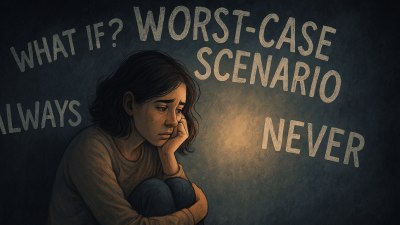Breaking the Spiral: My Personal Journey Through Catastrophizing
I’ve tried fighting catastrophizing, and I often blamed myself for not being able to make it go away... Here’s a list of what I’ve tried and what I personally find helpful

This image was created with the assistance of DALL·E
Today, I want to share my experience with catastrophizing. It usually happens when I face a problem or a situation where I don’t know what to expect. That’s when my mind starts showing me nasty scenarios of how things could go wrong. I’m talking about disturbing and very intrusive thoughts that you desperately want to push out of your mind—but the more you try to break free, the stronger they seem to get. These thoughts repeat themselves over and over and just won’t go away.
Some of the symptoms I’ve experienced include:
- Intrusive/obsessive thoughts
- Trouble sleeping or sleeping too much
- Negative self-talk
- Crying
- Constant worrying
- Desperation
I’ve tried fighting catastrophizing, and I often blamed myself for not being able to make it go away. At some point, I even started thinking that maybe I was going crazy. The truth is—fighting it doesn’t help. I’ve spent a lot of time reading about this problem and gathering some of the most popular advice from specialists. So, here’s a list of what I’ve tried and what I personally find helpful:
Journaling
They say it’s a good idea to write down what’s worrying you—and for me, this technique has been somewhat helpful. By doing this, you let the problem out of your head and onto the paper. Write as many details as you can: what exactly you’re worrying about, how it makes you feel, what you think is causing these intrusive thoughts, how long you’ve been having them—and most importantly—write down the exact thoughts you are experiencing, even if they seem unreasonable. When you read them later, you’ll often realize that either the fear is exaggerated or the problem isn’t as big as it initially seemed.
Worst Case Scenario / Best Case Scenario
This technique has actually helped me a lot. You can do it either in writing or just mentally. Once you’ve identified the problem that’s tormenting you, try to analyze it:
- What’s the worst thing that could happen?
- If it happens, what does it mean to you?
- How would it change your life?
- And most importantly—can you do something about it?
If the answer is “yes,” just get up and do it. If the answer is “no,” try to let it go.
After that, write down the best-case scenario. Ask yourself: is this problem even real? Could something good actually come from it? What’s the best that could happen? Chances are, the truth lies somewhere in the middle.
Positive Self-Talk
They say you are what you think, and that thoughts can manifest into reality. I believe there’s some truth to that. If you constantly think about something, sooner or later, you may attract it into your life. That’s why positive self-talk is important—but let’s be honest, it’s really hard to achieve, at least for me.
We all know what positive self-talk is; the real challenge is staying aware of your thoughts throughout the day. What’s helped me is turning positive self-talk into a daily habit. Every morning while brushing my teeth, I think about nice and positive things, and every night before bed, I focus on something good that happened during the day.
Meditation
Meditation is great for your mental health. It really helps you pause the constant worrying and ground yourself in the present moment, instead of obsessing over the past or the future.
I’ve tried both guided meditations and meditating on my own. For me, meditation works if I do it regularly. However, if I’m already caught in the worrying spiral, it doesn’t help much because I find it hard to relax at that point. So my advice is: don’t wait until you’re spiraling. Practice meditation daily as a preventive measure, not just as a cure.
Physical Exercise
This is my favorite tool for calming down when I’m anxious. Unlike meditation, physical movement gives me immediate relief. It’s like a pill that helps me stop worrying, even if it’s just for a while.
Whenever I start stressing about something, the best thing I can do is go for a long walk outside. Other great options are going to the gym, doing exercises at home, running in the park, doing push-ups, dancing, or any other sport you enjoy. Physical exercise helps me clear my mind and gain a new perspective on the problem I’m catastrophizing about.
Distraction
As you might guess, distraction doesn’t solve the problem. It just helps you get out of your head for a little while. It’s not a solution, but it can be a tool to break the spiral when things get too overwhelming.
There are countless ways to distract yourself. Personally, I like reading a book, watching a show, writing, talking to a friend, cleaning the house, cooking a meal—whatever comes to mind. Mind games and grounding exercises can also be helpful. I have written more about grounding techniques here: Tried and Tested: 5 Grounding Techniques That Actually Helped Me During Anxiety (And Might Help You Too)
Reality Check
This one is my favorite. Doing a reality check by yourself can be really difficult. That’s why I think it’s so important to seek an outside perspective when you’re catastrophizing.
For me, it’s my best friend who helps me with this. For you, it could be a relative, a partner, or a therapist. The key is to be honest—share your exact thoughts and worries, no matter how crazy they might sound. Only by being fully open can you get the support you need.
And you know what? Sometimes, when you finally share your worry out loud, you realize how small or unimportant it actually is.
Catastrophizing can feel overwhelming, but you are not alone—and you are not powerless. The more you learn to understand your thoughts and gently challenge them, the easier it becomes to step out of the spiral. Recovery doesn’t happen overnight, but every small step matters.
Be patient with yourself and remember: it’s okay to seek help along the way.
Important Note
This article is for informational purposes only and is not intended to replace professional advice, diagnosis, or treatment. If you are struggling with persistent anxiety, intrusive thoughts, or emotional distress, please seek the support of a qualified mental health professional.




